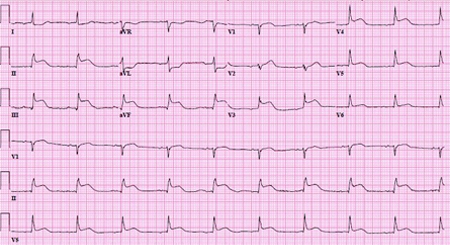Summary
Differentials
Common
- Chronic obstructive pulmonary disease (COPD)
- Congestive heart failure
- Asthma
- Pneumonia (bacterial, viral, fungal, tuberculous)
- Coronavirus disease 2019 (COVID-19)
- Croup
- Acute coronary syndrome (ACS)
- Stable angina
- Arrhythmias
- Interstitial lung disease
- Bronchiectasis
- Noninfective pneumonitis (eosinophilic, radiation, aspiration, hypersensitivity pneumonitis)
- Acute bronchitis
- Laryngitis
- Pulmonary embolism (thrombotic, air, amniotic fluid, tumor)
- Pleural effusion
- Pleuritis
- Anemia
- Gastroesophageal reflux disease (GERD)
- Ascites
- Shock
- Pulmonary tumors
- Anxiety and panic attacks
- Normal aging, deconditioning, and obesity
Uncommon
- Sepsis
- Aortic dissection
- Sarcoidosis
- Pulmonary contusion
- Epiglottitis
- Anaphylaxis
- Angioedema
- Foreign body aspiration
- Tracheobronchial tumors (benign or malignant)
- Retrosternal goiter
- Vocal cord dysfunction
- Pulmonary hypertension
- Hepatopulmonary syndrome
- Pulmonary arteriovenous malformations
- Pulmonary veno-occlusive disease
- Mesothelioma
- Pneumothorax and pneumomediastinum
- Hemothorax
- Acquired valvular heart disease
- Congenital heart disease
- Cardiac drugs
- Myocardial disease (cardiomyopathy, myocarditis)
- Pericardial disease
- Superior vena cava syndrome
- Methemoglobinemia and carbon monoxide poisoning
- Tetanus
- Botulism
- Phrenic nerve paralysis
- Amyotrophic lateral sclerosis
- Polio and other acute viral anterior horn infections
- Guillain-Barre syndrome
- Myasthenia gravis
- Respiratory muscle deficiency
- Paraneoplastic myasthenic syndrome
- Thyroid disease
- Cushing syndrome
- Pheochromocytoma
- Kyphoscoliosis and pectus excavatum
- Diphtheria
Contributors
Authors
Tomasz J. Kuzniar, MD, PhD

Clinical Assistant Professor of Medicine
University of Chicago
Division of Pulmonary and Critical Care Medicine
NorthShore University HealthSystem
Evanston
IL
Disclosures
TJK is coauthor of, and receives royalties from, two topics on sleep apnea for UpToDate.
Acknowledgements
Dr Tomasz J. Kuzniar would like to gratefully acknowledge Dr Kamilla Kasibowska-Kuzniar and Dr Kaiser G. Lim, previous contributors to this topic.
Disclosures
KK-K and KGL declare that they have no competing interests.
Peer reviewers
Nicholas Maskell, MD
Senior Lecturer and Consultant Physician
North Bristol Lung Centre
Southmead Hospital
Bristol
UK
Disclosures
NM declares that he has no competing interests.
Najib Rahman, BM, BCh, MA (Oxon), MRCP (UK)
MRC Training Fellow and Specialist Registrar, Respiratory Medicine
Oxford Centre for Respiratory Medicine
Churchill Hospital
Oxford
UK
Disclosures
NR declares that he has no competing interests.
Jonathan P. Parsons, MD
Assistant Professor
Division of Pulmonary, Allergy, Critical Care and Sleep Medicine
Ohio State University Medical Center
Columbus
OH
Disclosures
JPP declares that he has no competing interests.
Peer reviewer acknowledgements
BMJ Best Practice topics are updated on a rolling basis in line with developments in evidence and guidance. The peer reviewers listed here have reviewed the content at least once during the history of the topic.
Disclosures
Peer reviewer affiliations and disclosures pertain to the time of the review.
References
Key articles
American College of Radiology. ACR appropriateness criteria: chronic dyspnea - noncardiovascular origin. 2024 [internet publication].Full text
Global Initiative for Asthma. Global strategy for asthma management and prevention. May 2025 [internet publication].Full text
Global Initiative for Chronic Obstructive Lung Disease. Global strategy for prevention, diagnosis and management of COPD: 2025 report. 2024 [internet publication].Full text
Konstantinides SV, Meyer G, Becattini C, et al. 2019 ESC guidelines for the diagnosis and management of acute pulmonary embolism developed in collaboration with the European Respiratory Society (ERS): the Task Force for the diagnosis and management of acute pulmonary embolism of the European Society of Cardiology (ESC). Eur Respir J. 2019 Sep;543-603.Full text Abstract
Heidenreich PA, Bozkurt B, Aguilar D, et al. 2022 AHA/ACC/HFSA guideline for the management of heart failure: a report of the American College of Cardiology/American Heart Association Joint Committee on clinical practice guidelines. Circulation. 2022 May 3;145(18):e895-1032.Full text Abstract
Reference articles
A full list of sources referenced in this topic is available to users with access to all of BMJ Best Practice.

Patient information
Anxiety
Anxiety: questions to ask your doctor
More Patient informationCalculators
Community-acquired pneumonia severity index (PSI) for adults
CURB-65 pneumonia severity score
More CalculatorsVideos
Nasopharyngeal airway: animated demonstration
Oropharyngeal airway: animated demonstration
More videosLog in or subscribe to access all of BMJ Best Practice
Use of this content is subject to our disclaimer